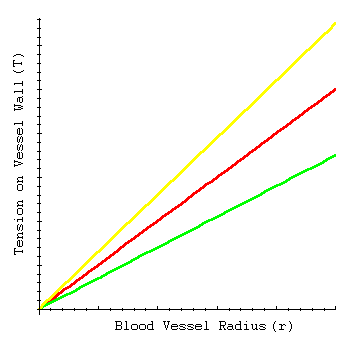
TENSION IN BLOOD VESSELS: LAPLACE'S EQUATION
Introduction: The closed circulatory system of vertebrates is composed of arteries, veins, and capillaries. Arteries are thick walled and carry blood away from the heart. Veins carry blood to the heart. Capillaries are small tubes that connect arterioles (small arteries) and venules (small veins).
Importance: We can use an equation describing the tension in the wall of a hollow cyllinder in order to gather information about the construction of blood vessels and understand why the types of blood vessels differ in thickness and size.
Question: How does is the tension in the walls of blood vessels affected by their thickness and size? Does the size and thickness of blood vessels make sense considering their particular roles?
Variables:
|
T |
tension in the blood vessel wall (kg/s2 |
|
r |
radius of the blood vessel (mm) |
|
p |
pressure across the vessel wall (kPa) |
Methods: LaPlace's equation assumes the tension (T) in the wall of a hollow cyllinder is directly proportional to the cyllinder's radius (r) and the pressure (p) across the wall caused by the flow inside:
T = p
´ rWe can assess properties concerning the thickness and size of veins and arteries by using LaPlace's equation. We will plot T as a linear function of r for different values of p.

Interpretation: For a given blood pressure, increasing the radius of the cyllinder leads to a linear increase in tension. This implies that large arteries must have thicker walls than small arteries in order to withstand the level of tension.
Notice that as we increase the pressure (p) we increase the slope of the line. For a given radius (r), cyllinders carrying a higher pressure of flow also have higher tension. We can extend this idea to similar sized veins and arteries. Arteries must have thicker walls than veins because they carry much higher blood pressure.
Capillaries also carry high blood pressure, but unlike arteries, capillary walls are thin. This is because their small size leads to a reduced level of tension so that thick walls are not necessary.
Conclusions: A simple equation quantifying the tension in the walls of a cyllinder can be related to blood vessels. Properties of this relationship helps us understand the variable thickness of arteries, veins, and capillaries.
Source: Schmidt-Nielsen, K. 1990, Animal Physiology: Adaptation and environment, Cambridge University Press, Cambridge
Copyright 1999 M. Beals, L. Gross, S. Harrell